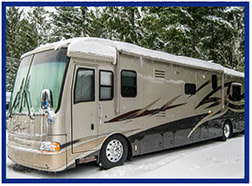
- Exterior: The most frequently encountered issue with RV's in storage is water leaks. Inspect all the caulking to be sure it is not cracked or missing. This includes caulking around windows, doors, all roof vents and seams. Even the smallest crack will allow water to intrude, Wash the unit using proper cleaners so the surface is not damaged. Pay particular attention to the awning.
- Interior: Give the interior a quick dusting and vacuum, checking all around inside for areas that may need cleaned.
- Tires: Inspect tires for cracks on the sidewall and between treads. Replace tires if cracks are noted to avoid any blowouts while on the road. Check tire pressure per manufacturer recommended tire pressure which is located on a decal inside of your cabinet.
- Appliances: Remove the outside access covers for the water heater and refrigerator. Inspect the burner assembly for any foreign debris such as spider webs and nests. Light air pressure from a compressor can be used to clean the burner area (do not blow high pressure up the refrigerator chimney).
- Batteries: When in doubt please have a professional address. You should be wearing safety glasses and latex gloves, disconnect the shore power, have main cut off in off position before getting started:
- Clean corroded terminals, connections, and battery trays using hot water and baking soda.
- Check battery fluid levels where practical. Be careful with wiring if removing the batteries as positive and negative wires are not color coded often (use masking tape and a sharpie to flag). Remember that improper battery connections will lead to mass component failure. The goal here is to check batteries for fluid. Top fluid levels off with distilled water but pay attention as you don't want to overfill. Keep the level below the upper case fill ring.
- Have a professional complete a load test. Batteries must be fully charged before the test otherwise they will fail the load test. If the professional testing the battery does not check the state of charge, go elsewhere as the vendor is likely pushing to sell new batteries.
- If battery replacement is required always replace multiple battery banks together. Do not add an old battery to a new battery.
- LP: Make sure the L.P. components turned off before proceeding forward. Turn the leak detector inside the RV on first and open the valve on the tank all the way. Smell around the area for leaks (can also use an electronic leak detector), using soapy water to check for leaks around the valve and regulator. If a leak is detected turn off the L.P. valve immediately and consult with a professional to repair the leak. Please note that sometimes seals dry out over the winter causing new leaks. Last but certainly not least, absolutely no smoking/flames/sparks while completing this step.
- Water: The hot water heater bypass valve needs to be in the "normal" position and all faucets need to be closed prior to filling with water. Open a hot and cold water faucet during filling to allow the air to escape until the water flows steady. Inspect faucets, water heater over pressure safety valve, and the water heater drain plug for leaks.
- Test fire appliances: With the L.P. gas leak detector on, start by lighting a stove top burner. This is the easiest flame to see, so you will know when it ignites and the air in the lines is purged. Light the other L.P. fired items, making sure the water heater is full before igniting.
- Generator: Some newer generators have a prime function to run the fuel pump prior to starting. Hold the start-stop switch in the stop position, one the light in the switch is illuminated run the pump for about 20 seconds to deliver fuel to the carburetor. If the generator does not have a prime feature, you will have to crank it until it starts. Let the starter rest to cool after about 15 seconds of cranking. Cycle the starter until it runs. Let it run for a short time and check the oil level. Check the air filter to rule out any critters nesting from storage. Check the owner's manual for any other procedures.
- Dump Hoses: Inspect the sewage dump hose. Dump hoses have a limited shelf life. Verify that the hose is in good condition with no tears or holes.
- Waste tank valves: Run the waste tank valves while connected to a dump station. Valve seals can dry out making the valves difficult to operate. Slowly working the handle in and out in short increments may save replacing the valves. There are also additives for valve lubrication that can be added to the tanks.
- Awnings: Simply operate awnings and inspect fabric. The spring tension may need to be adjusted if you have difficulty extending the awning. Spring adjustment is dangerous and we would highly recommend hiring a professional to address issues.
- Water Heater: Remove the drain plug at the bottom of the tank and allow any sediment to escape with the water. Some models also have an anode rod that is part of the drain plug. With the tank drained check the anode for deterioration and rule out replacement. Inspect the rod and replace it if it is more than 75 percent depleted. Refer to the water heater's instruction manual for replacement details. Reinstall the drain plug and refill the tank before lighting the burner.
- Freshwater Tanks: Should be sanitized by filling the water tank half full. Add a solution of 1/4-cup household bleach and 1 gallon of water for every 15 gallons of tank capacity. Open all the faucets until all air has been bled from the system and the water coming out has the odor of the bleach solution before shutting off the taps. After three to five hours, drain the water system and refill it with fresh water. Run water through all faucets and then drain the system again.
- Radiator: Hoses to be replaced about every five years. Although they may look fine from the outside, many times they deteriorate inside first. They can then burst without warning and you fail to notice the temperature gauge, severe engine damage may result.
GET NH RV MOTOR HOME OR CAMPER INSURANCE QUOTE HERE




 RSS Feed
RSS Feed
